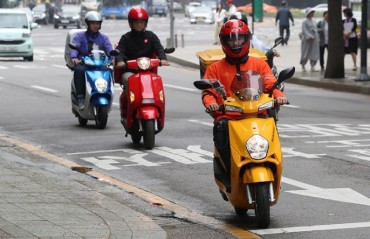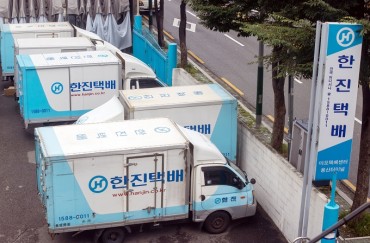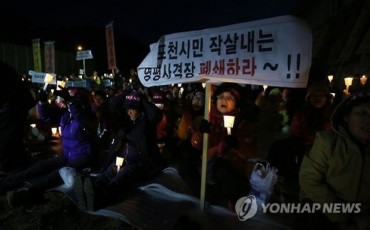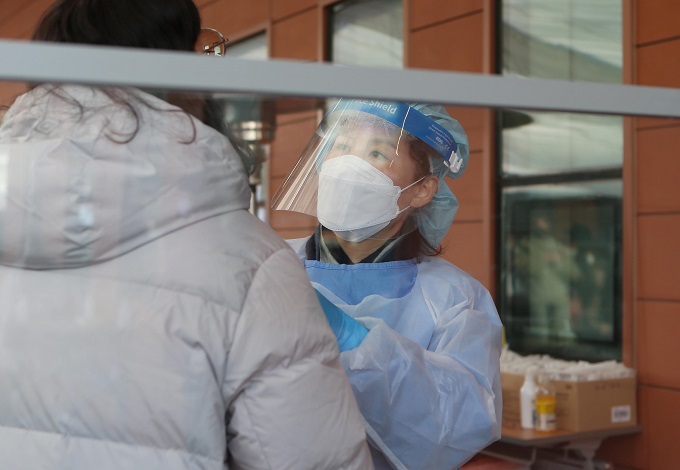
A health worker conducts a coronavirus test in the southern city of Changwon, South Gyeongsang Province, on Feb. 2, 2022. (Yonhap)
SEOUL, Feb. 3 (Korea Bizwire) — South Korea broke its single-day COVID-19 case record again Thursday with infections topping 20,000 for the second day in a row, as holiday gatherings and travel fueled omicron’s fast spread.
The country reported 22,907 new virus infections, including 22,773 local cases, raising the total to 907,214, according to the Korea Disease Control and Prevention Agency (KDCA).
The previous daily record was 20,269 reported on Wednesday. The health authorities revised down the daily caseload by one from the 20,270 it had originally reported.
The death toll from COVID-19 came to 6,812, up 25 from a day earlier. The fatality rate was 0.75 percent, lower than the 0.9 percent range seen before omicron became the dominant variant in mid-January.
Critical cases of COVID-19 were 274, down four from the previous day.
As of 9 p.m., the country had added 22,345 new COVID-19 cases, the largest ever by this hour and up 4,425 from the same time the previous day, according to health authorities and city governments.
The greater Seoul area accounted for 57.7 percent, or 12,900.
Daily cases are counted until midnight and announced the following morning.
“New infections among people aged 60 or over have dropped significantly compared with the previous delta-led wave and a rise in critically ill patients is expected to further slow down,” Son Young-rae, spokesperson for the Ministry of Health and Welfare, said at a daily coronavirus briefing Thursday.
He also said that South Korea’s health system can handle up to 50,000 COVID-19 daily cases as “hospitalizations have decreased and asymptomatic cases have risen since omicron became dominant.”
As of 5 p.m. Wednesday, intensive care unit beds for critically ill COVID-19 patients were 16.1 percent full nationwide.
At-home care patients rose 7,716 from the previous day to a total of 97,136, accounting for 89.1 percent of the country’s maximum care capacity for those who are treated at home.
Health authorities have warned that the five-day Lunar New Year holiday, which ended Wednesday, could send virus cases to new heights in the weeks to come.
The education ministry said it will hold a virtual meeting Friday with school superintendents across the country to discuss antivirus measures for schools and how to run the academic schedules for the new semester starting in March.
Details on the school quarantine policy and schedules will be finalized and announced next week.
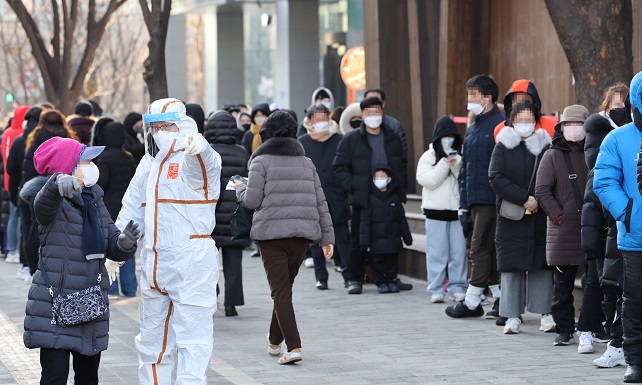
People wait in line at a testing site at Songpa Public Health Center in Seoul on Feb. 3, 2022. (Yonhap)
As South Korea averaged 18,533 daily cases over the past week, which is higher than the government had expected, the country enforced a new testing regime on Thursday to more effectively deal with the omicron-fueled COVID-19 wave and prevent hospitals from being overwhelmed.
Under the new system, only those who test positive in rapid antigen tests will be able to receive polymerase chain reaction (PCR) tests in principle. People aged over 60 or in high-risk groups, such as those with underlying health conditions, will be prioritized for PCR tests.
Approximately 700 neighborhood clinics and respiratory hospitals were expected to begin on Thursday offering coronavirus testings and treatments for at-home care patients.
But the actual number of hospitals participating in the government’s plan on the first day turned out to be much smaller, causing confusion and disappointment among people who suffer from COVID-19-like symptoms and need to seek medical help.
The government said the number will gradually increase, as more than 1,000 hospitals nationwide signed up for the plan.
Of the locally transmitted cases, Gyeonggi Province that surrounds Seoul reported 6,532, followed by Seoul with 5,191 and the western port city of Incheon with 1,533. Cases from overseas rose 134 to 25,808.
As of Thursday, 27.26 million people, or 53 percent of the country’s 52 million population, had received booster shots. The number of fully vaccinated people came to 43.99 million people, accounting for 85.7 percent.
The KDCA said an additional 615,000 doses of the Pfizer vaccine arrived in South Korea late Thursday. That raised the cumulative COVID-19 vaccine supply delivered here to 3.08 million doses.
South Korea has secured a total of 150.4 million doses of COVID-19 vaccines, including 60 million doses of Pfizer and 2.84 million doses of Moderna, according to the KDCA.
(Yonhap)



